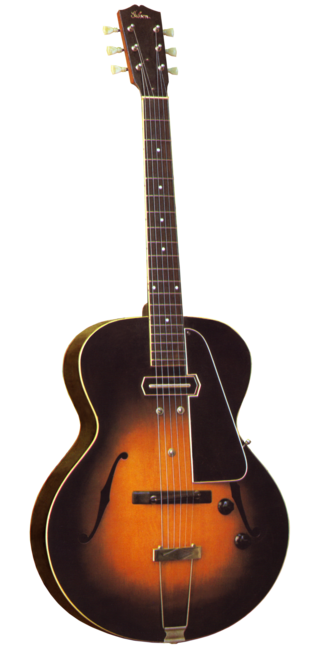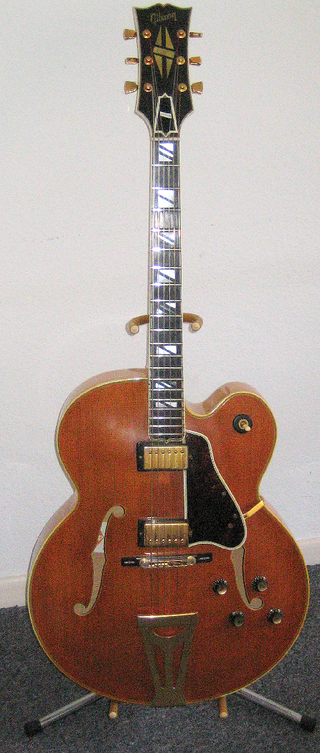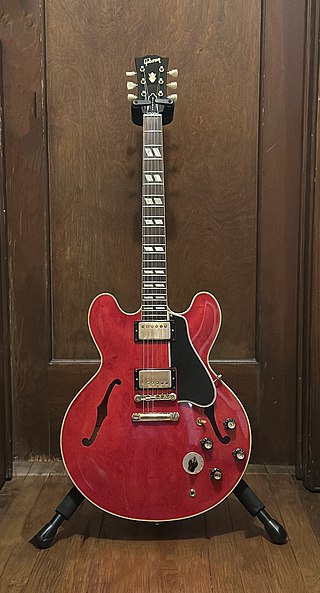
An electric guitar is a guitar that requires external amplification in order to be heard at typical performance volumes, unlike a standard acoustic guitar. It uses one or more pickups to convert the vibration of its strings into electrical signals, which ultimately are reproduced as sound by loudspeakers. The sound is sometimes shaped or electronically altered to achieve different timbres or tonal qualities from that of an acoustic guitar via amplifier settings or knobs on the guitar. Often, this is done through the use of effects such as reverb, distortion and "overdrive"; the latter is considered to be a key element of electric blues guitar music and jazz, rock and heavy-metal guitar-playing. Designs also exist combining attributes of the electric and acoustic guitars: the semi-acoustic and acoustic-electric guitars.

A semi-acoustic guitar, also known as a hollow-body electric guitar, is a type of electric guitar designed to be played with a guitar amplifier featuring a fully or partly hollow body and at least one electromagnetic pickup. First created in the 1930s, they became popular in jazz and blues, where they remain widely used, and the early period of rock & roll, though they were later largely supplanted by solid-body electric guitars in rock.

The Gibson ES-335 is a semi-hollow body semi-acoustic guitar introduced by the Gibson Guitar Corporation as part of its ES series in 1958. It features a solid maple wood block running through the center of its body with upper bouts that are hollow and two violin-style f-holes cut into the top over the hollow chambers. Since its release, Gibson has released numerous variations of and other models based on the design of the ES-335.

An archtop guitar is a hollow acoustic or semi-acoustic guitar with a full body and a distinctive arched top, whose sound is particularly popular with jazz, blues, and rockabilly players.
The Fender Jaguar is an electric guitar by Fender Musical Instruments characterized by an offset-waist body, a relatively unusual switching system with two separate circuits for lead and rhythm, and a short-scale 24" neck. Owing some roots to the Jazzmaster, it was introduced in 1962 as Fender's feature-laden top-of-the-line model, designed to lure players from Gibson. During its initial 13-year production run, the Jaguar did not sell as well as the less expensive Stratocaster and Telecaster, and achieved its most noticeable popularity in the surf music scene. After the Jaguar was taken out of production in 1975, vintage Jaguars became popular first with American punk rock players, and then more so during the alternative rock, shoegazing and indie rock movements of the 1980s and 1990s. Fender began making a version in Japan in the mid-1980s, and then introduced a USA-made reissue in 1999. Since then, Fender has made a variety of Jaguars in America, Mexico, Indonesia and China under both the Fender and Squier labels. Original vintage Jaguars sell for many times their original price.

The Gibson ES-125 is an archtop, hollow body electric guitar model that was produced by the Gibson Guitar Corporation.
The Gibson EB-3 is an electric bass guitar model produced by the Gibson Guitar Corporation.

The Gibson ES-355 is the top of the line semi-hollow body thinline guitar from the Gibson Guitar Company. The guitar was a stereo guitar with a varitone circuit and it was manufactured from 1958 to 1982. In 2018 Gibson began producing a version of the 355 again.

The Gibson Blueshawk is a discontinued model of semi-hollow body electric guitar. It was available between 1996 and 2006 as a Gibson model designed mainly for blues players. It superficially resembles the Les Paul in that the body outline is similar. The Blueshawk was discontinued by Gibson in Spring 2006, and returned in 2015 under the Epiphone brand.
A solid-body musical instrument is a string instrument such as a guitar, bass or violin built without its normal sound box and relying on an electromagnetic pickup system to directly detect the vibrations of the strings; these instruments are usually plugged into an instrument amplifier and loudspeaker to be heard. Solid-body instruments are preferred in situations where acoustic feedback may otherwise be a problem and are inherently both less expensive to build and more rugged than acoustic electric instruments.

The Gibson ES-135 is a semi-hollow body electric guitar made by the Gibson Guitar Corporation. Originally introduced in 1956, it was discontinued in 1958. Some guitars were stamped with and marketed as an ES-130. The original run amounted to 556 instruments produced. The model, with some modifications, was reintroduced in 1991 and remained in production until 2004.
The Fender Telecaster Thinline is a semi-hollow guitar made by the Fender company. It is a Telecaster with body cavities. Designed by German luthier Roger Rossmeisl in 1968, it was introduced in 1969 and updated in 1972 by replacing the standard Telecaster pickups with a pair of Fender Wide Range humbucking pickups, bullet truss-rod and 3-bolt neck.

The Gibson Nighthawk was a family of electric guitars manufactured by Gibson. Introduced in 1993, the Nighthawk represented a radical change from traditional Gibson designs. While its maple-capped mahogany body and set neck were reminiscent of the classic Gibson Les Paul, the Nighthawk incorporated a number of characteristics more commonly associated with Fender guitars. The Nighthawk was not a commercial success; production of all models was discontinued in 1998 after only five years.
Electric guitar design is a type of industrial design where the looks and efficiency of the shape as well as the acoustical aspects of the guitar are important factors. In the past many guitars have been designed with various odd shapes as well as very practical and convenient solutions to improve the usability of the object.
The Gibson ES series of semi-acoustic guitars are manufactured by the Gibson Guitar Corporation.

Duesenberg is a brand for electric string instruments founded in 1986 and located in Hannover, Germany. The headquarter is in Hannover, Germany, they are known for using a Plek machine for the levelling of frets and setup. Duesenberg has uploaded a factory production video of how their guitars are made, revealing that most of the production of the guitars is done in Croatia, while the final setup and assembly is done in Germany.

The Gibson ES-345 is a guitar manufactured by the Gibson Guitar Company. The guitar was produced from 1959 to 1981. It was designed as a jazz guitar and an upscale version of the ES-335.
The Fender Telecaster, colloquially known as the Tele, is an electric guitar produced by Fender. Together with its sister model the Esquire, it was the world's first mass-produced, commercially successful solid-body electric guitar. Its simple yet effective design and revolutionary sound broke ground and set trends in electric guitar manufacturing and popular music. Many prominent rock musicians have been associated with the Telecaster for use in studio recording and live performances, most notably Bruce Springsteen, Luis Alberto Spinetta, Keith Richards and George Harrison.

The Gibson ES-350T is an electric guitar model from Gibson Guitar Corporation, released in 1955. The ES-350T is a further development of the Gibson ES-350 model from 1948 and as such has a completely hollow body. The unique feature of the Gibson ES-350T at the time of its market introduction was the reduced width of the rims. As a result, the guitar has a thinner body compared to instruments with a resonance body that is of full thickness. The ES-350T, together with its sister models Gibson ES-225 TDN and Gibson Byrdland, was one of the first models of the thinline guitar type.












